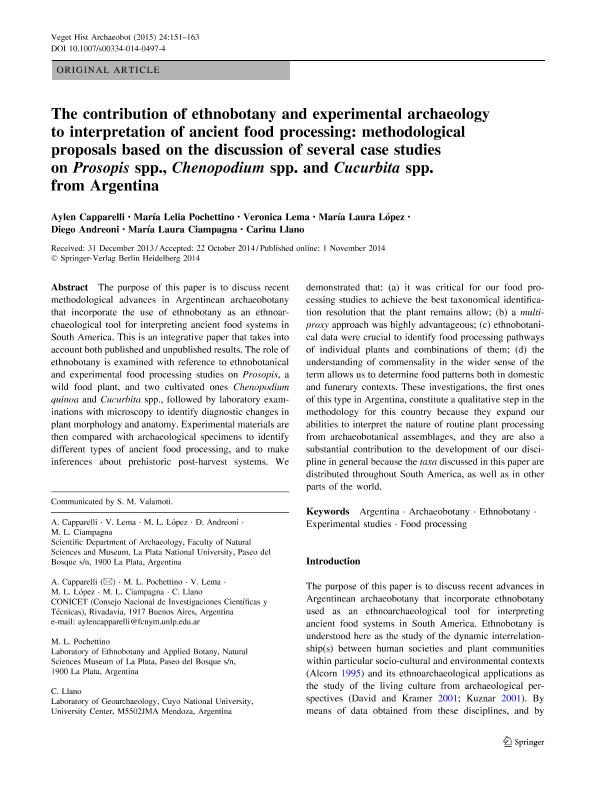Mostrar el registro sencillo del ítem
dc.contributor.author
Capparelli, Aylen

dc.contributor.author
Pochettino, María Lelia

dc.contributor.author
Lema, Veronica Soledad

dc.contributor.author
Lopez, María Laura

dc.contributor.author
Andreoni, Diego Fernando

dc.contributor.author
Ciampagna, María Laura

dc.contributor.author
Llano, Carina Lourdes

dc.date.available
2018-01-08T16:48:10Z
dc.date.issued
2014-09
dc.identifier.citation
Lema, Veronica Soledad; Llano, Carina Lourdes; Lopez, María Laura; Ciampagna, María Laura; Capparelli, Aylen; Pochettino, María Lelia; et al.; The contribution of ethnobotany and experimental archaeology to interpretation of ancient food processing: methodological proposals based on the discussion of several case studies on Prosopis spp., Chenopodium spp. and Cucurbita spp. from Argentina; Springer; Vegetation History And Archaeobotany; 24; 1; 9-2014; 151-163
dc.identifier.issn
0939-6314
dc.identifier.uri
http://hdl.handle.net/11336/32518
dc.description.abstract
The purpose of this paper is to discuss recentmethodological advances in Argentinean archaeobotanythat incorporate the use of ethnobotany as an ethnoar-chaeological tool for interpreting ancient food systems inSouth America. This is an integrative paper that takes intoaccount both published and unpublished results. The role ofethnobotany is examined with reference to ethnobotanicaland experimental food processing studies onProsopis,awild food plant, and two cultivated onesChenopodiumquinoaandCucurbitaspp., followed by laboratory exam-inations with microscopy to identify diagnostic changes inplant morphology and anatomy. Experimental materials arethen compared with archaeological specimens to identifydifferent types of ancient food processing, and to makeinferences about prehistoric post-harvest systems. Wedemonstrated that: (a) it was critical for our food pro-cessing studies to achieve the best taxonomical identifica-tion resolution that the plant remains allow; (b) amulti-proxyapproach was highly advantageous; (c) ethnobotani-cal data were crucial to identify food processing pathwaysof individual plants and combinations of them; (d) theunderstanding of commensality in the wider sense of theterm allows us to determine food patterns both in domesticand funerary contexts. These investigations, the first onesof this type in Argentina, constitute a qualitative step in themethodology for this country because they expand ourabilities to interpret the nature of routine plant processingfrom archaeobotanical assemblages, and they are also asubstantial contribution to the development of our disci-pline in general because thetaxadiscussed in this paper aredistributed throughout South America, as well as in otherparts of the world.
dc.format
application/pdf
dc.language.iso
eng
dc.publisher
Springer

dc.rights
info:eu-repo/semantics/openAccess
dc.rights.uri
https://creativecommons.org/licenses/by-nc-sa/2.5/ar/
dc.subject
Argentina
dc.subject
Archaeobotany
dc.subject
Ethnobotany
dc.subject
Experimental Studies
dc.subject
Food Processing
dc.subject.classification
Historia

dc.subject.classification
Historia y Arqueología

dc.subject.classification
HUMANIDADES

dc.title
The contribution of ethnobotany and experimental archaeology to interpretation of ancient food processing: methodological proposals based on the discussion of several case studies on Prosopis spp., Chenopodium spp. and Cucurbita spp. from Argentina
dc.type
info:eu-repo/semantics/article
dc.type
info:ar-repo/semantics/artículo
dc.type
info:eu-repo/semantics/publishedVersion
dc.date.updated
2018-01-03T20:01:55Z
dc.journal.volume
24
dc.journal.number
1
dc.journal.pagination
151-163
dc.journal.pais
Alemania

dc.journal.ciudad
Berlin
dc.description.fil
Fil: Capparelli, Aylen. Consejo Nacional de Investigaciones Científicas y Técnicas; Argentina. Universidad Nacional de La Plata. Facultad de Ciencias Naturales y Museo. Departamento Científico de Arqueología; Argentina
dc.description.fil
Fil: Pochettino, María Lelia. Consejo Nacional de Investigaciones Científicas y Técnicas; Argentina. Universidad Nacional de La Plata. Facultad de Ciencias Naturales y Museo. Laboratorio de Etnobotánica y Botánica Aplicada; Argentina
dc.description.fil
Fil: Lema, Veronica Soledad. Consejo Nacional de Investigaciones Científicas y Técnicas; Argentina. Universidad Nacional de La Plata. Facultad de Ciencias Naturales y Museo. Departamento Científico de Arqueología; Argentina
dc.description.fil
Fil: Lopez, María Laura. Consejo Nacional de Investigaciones Científicas y Técnicas; Argentina. Universidad Nacional de La Plata. Facultad de Ciencias Naturales y Museo. Departamento Científico de Arqueología; Argentina
dc.description.fil
Fil: Andreoni, Diego Fernando. Universidad Nacional de La Plata. Facultad de Ciencias Naturales y Museo. Departamento Científico de Arqueología; Argentina
dc.description.fil
Fil: Ciampagna, María Laura. Consejo Nacional de Investigaciones Científicas y Técnicas; Argentina. Universidad Nacional de La Plata. Facultad de Ciencias Naturales y Museo. Departamento Científico de Arqueología; Argentina
dc.description.fil
Fil: Llano, Carina Lourdes. Consejo Nacional de Investigaciones Científicas y Técnicas; Argentina. Universidad Nacional de Cuyo; Argentina
dc.journal.title
Vegetation History And Archaeobotany

dc.relation.alternativeid
info:eu-repo/semantics/altIdentifier/doi/http://dx.doi.org/10.1007/s00334-014-0497-4
dc.relation.alternativeid
info:eu-repo/semantics/altIdentifier/url/https://link.springer.com/article/10.1007%2Fs00334-014-0497-4
Archivos asociados
